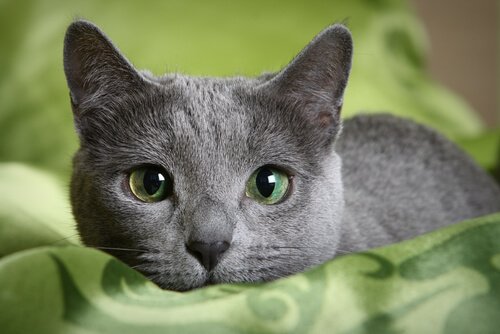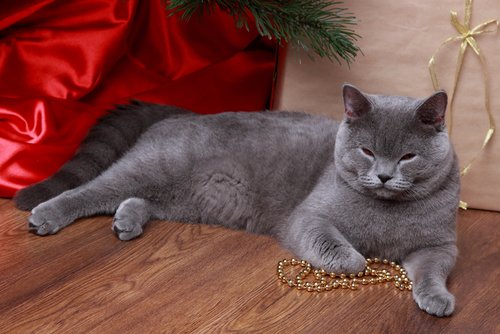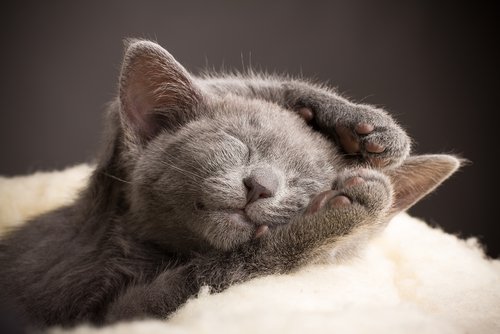Meet the Russian Blue Cat

One of the most famous and admired breeds in the world, the Russian blue cat is easy to fall in love with. Its popularity comes from its incredible physical beauty and charming personality.
The origins of the Russian blue
We know that the Russian blue is originally from the Archangel Islands in northern Russia (which is why the breed is sometimes also called the Archangel Blue), but the details are not entirely clear. Specialists and researchers do consider the Russian blue to be one of the oldest natural cat breeds that we know of.
In the absence of proof and documentation, much of the origin story of this domesticated feline belongs to the imagination.

Some claim that the Russian blue descends from cats that used to serve as companions to the old Russian tsars. Others claim that, for a time, Russian blues were hunted indiscriminately, for their striking, silky fur to adorn jacket sleeves and collars.
The only thing that is absolutely certain is that Russian blue left Russia for the first time in the 1860’s, on merchant ships that took them to England, where the aristocracy quickly adopted them. Currently, because of this royal history, Russian blues are one of the most popular breeds entered into cat beauty contests.
General characteristics
The Russian blue cat differs from other cat breeds because of its unique coat. It is bluish gray, with slightly silvery reflections, short and fine.
Although it’s not very common, there are also some cats with slightly longer fur. A Russian blue’s fur has a double layer, giving it a special texture. It feels nice to pet, in short.
Another distinctive point are the Russian blue’s large, green, almond-shaped eyes. Their face has perfectly balanced features. It’s the ideal size, with a short snout and prominent whiskers. Their mouth rises slightly in the corners, as if they were always smiling. Russian blue ears are long and pointed.
The Russian blue is a medium-sized cat, with males weighing between 3.5 and 5 Kg. and females weighing between 2.5 and 4 Kg. Their frame is slight, but with a robust, strong body.
The Russian blue as a pet
The Russian blue’s sweet, kind, affectionate personality, as well as high level of intelligence, are other reasons for the breed’s immense popularity. Russian blues love to be petted, so owners should enjoy cuddling with their cat.
They are playful. In addition, they’re comfortable with children, other cats and even dogs. Like most cats, they tend to be shy with strangers. Russian blues learn house rules quickly. They are extremely expressive and loyal to their families. Another part of their personality is that, although they enjoy the consistent company of their humans, they are fine alone for long periods of time.
There are two things that the Russian blue cat does not tolerate: changes in routine and lack of hygiene. The breed is fixed in its ways and stubborn about maintaining a schedule. Russian blues always need to eat at the same time, and they need to explore their house and surroundings.
Any variation in their daily schedule irritates them. But the hardest change is moving house. Therefore, this breed is not suitable for families that that have to move a lot.

Regarding grooming and hygiene, Russian blues are the fussiest cat breed about cleaning their litter box. They need their owners to change their litter daily. Otherwise, in protest, they will begin to urinate and leave droppings next to the litter box.
Health and care
Due to its “pure” character (not born of any crossbreeding), the Russian blue is one of the healthiest cat breeds. There is no known genetic problems or propensity for disease. In fact, the Russian blue’s life expectancy is quite high, comparatively speaking, as they often live beyond the 15-year mark.
Similarly, in comparison to other breeds, the Russian blue does not shed much. They also do not require any special grooming. Those who want their furniture 100% hair-free just need to brush their Russian blue once a week.
All cited sources were thoroughly reviewed by our team to ensure their quality, reliability, currency, and validity. The bibliography of this article was considered reliable and of academic or scientific accuracy.
- Association for Pet Obesity. (2023). 2022 Pet Obesity Prevalence Survey. https://www.petobesityprevention.org/2022
- Brown, J. (13 de octubre de 2023). Russian Blue: Cat Breed Profile, Characteristics, and Care. The Spruce Pets. https://www.thesprucepets.com/russian-blue-cat-4580390
- Öhlund, M., Palmgren, M., & Holst, B. S. (2018). Overweight in adult cats: a cross-sectional study. Acta veterinaria Scandinavica, 60(1), 1-10. https://www.ncbi.nlm.nih.gov/pmc/articles/PMC5775588/
- Seymour, K. (Mayo 10 de 2023). Russian Blue: Cat Breed Health and Care. PetMD. https://www.petmd.com/cat/breeds/russian-blue
- The International Cat Association. (1 de mayo de 2004). Russian Blue (RB) Breed Standard. TICA Breed Standard. https://tica.org/phocadownload/rb.pdf
- World Cat Federation. (1 de julio de 2019). Russian Blue (RUS). WCF Breedstandard. https://wcf.de/pdf-en/breed/Russian-Blue_2019-07-01_EN.pdf
